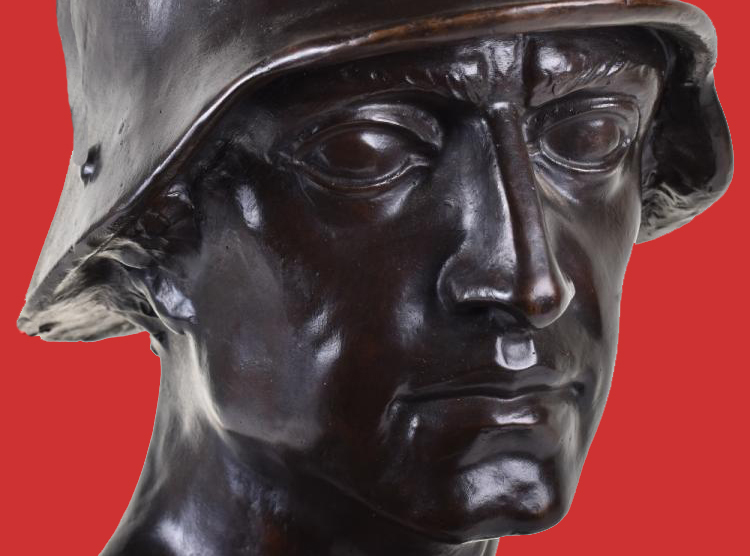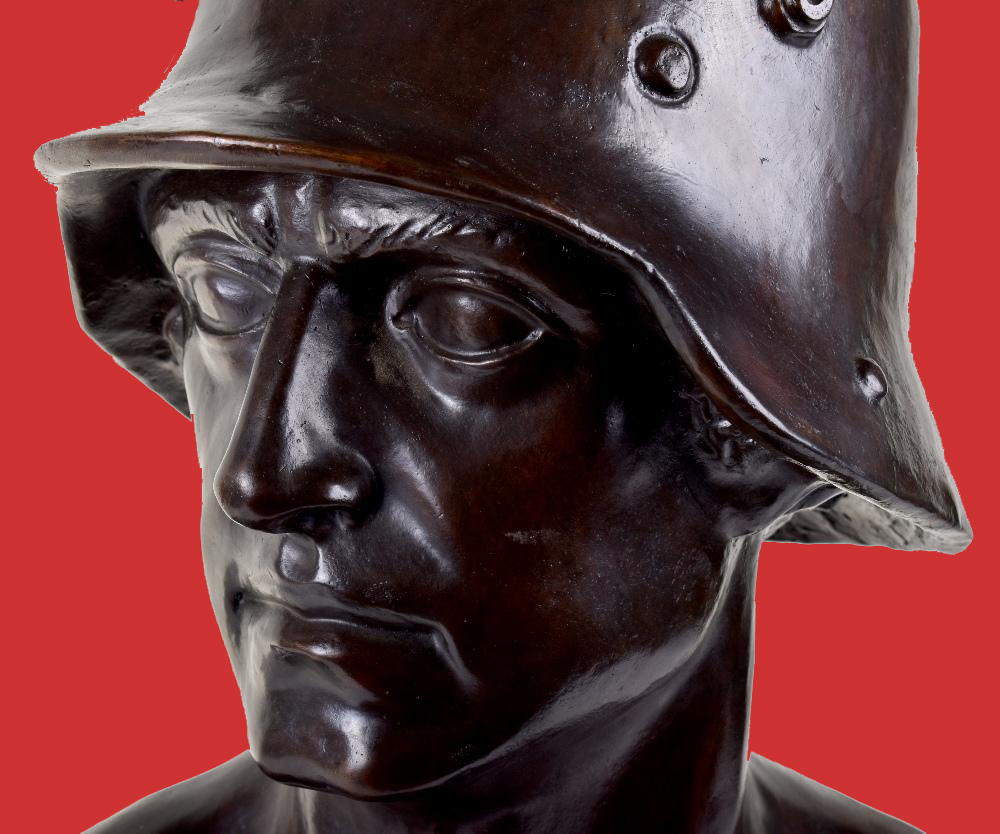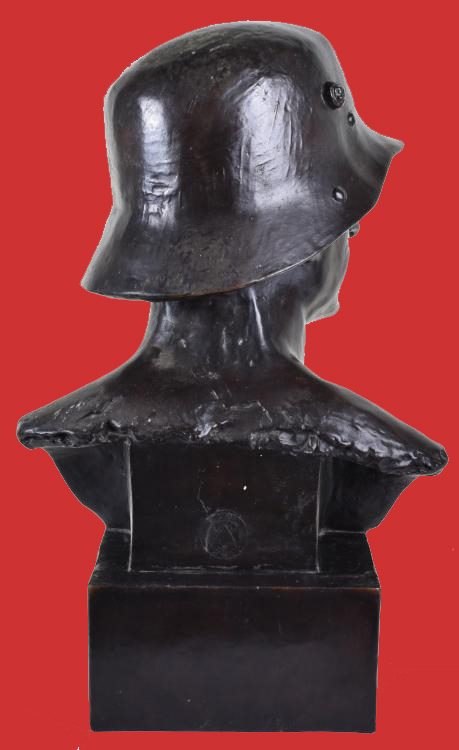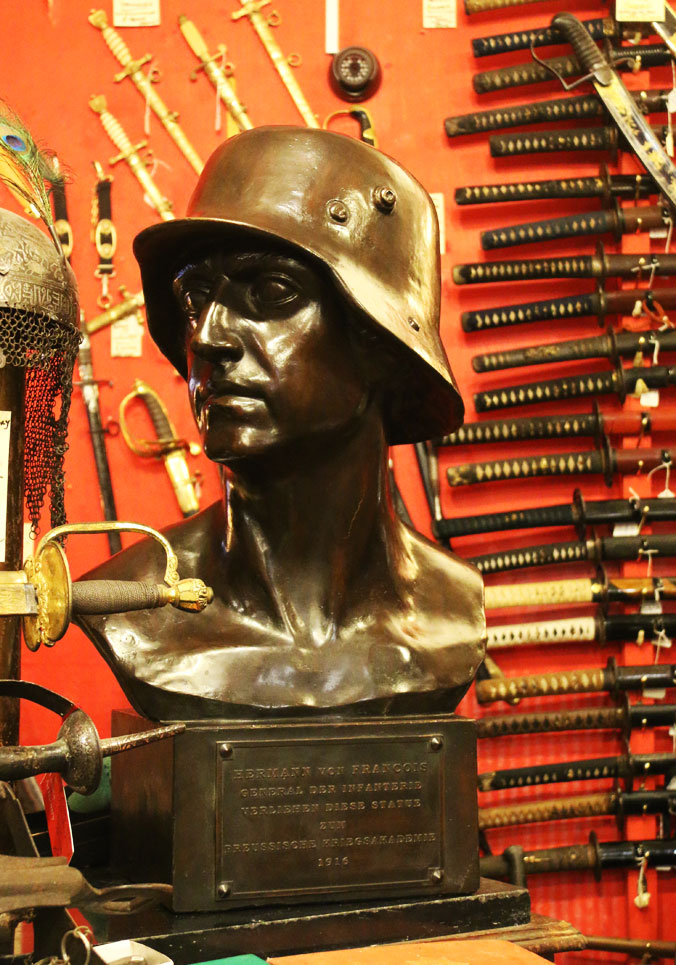Magnificent Bronze Military Warrior Bust, Bearing a Presentation. Plaque From the Famed Imperial German General von Francois. Although it Depicts the Imperial German Soldier This Bust Was Adopted as the Iconic Symbol of the Third Reich in the 1930’s.
A simply fabulous and huge bronze statuary bust of a traditional German combat helmeted, Imperial German WW1 Soldier, almost twice life size. The award panel in German states translation 'General Hermann von Francois, Awards this statue to the Prussian War Academy,1916'. Apparently the award was made in late 1916, but it was not completed, and thus located into the Academy, on behalf of the General, untill 1917. Somewhat akin the award of a medal of valour for gallantry, the award is made for an event on one date, but not officially conferred until the special presentation award ceremony, sometime later.
The general was known throughout Germany as the ‘Hero of the Battle of Tannenberg’ .
Mounted to a large squared bronze base which has a plaque to the centre, bearing the dedication in German; "Herman von Francois, General of the Infantry Presents this Statue to the Prussian War Academy 1916" The reverse of the bust has a foundry stamp of a pyramid. It stands 2 feet 1 1/4 inches high, weighing approx 120 pounds.
Hermann Karl Bruno von Francois, was one of the more famous German Generals of WW1. He was most admired and reknown for his decisive victory against the Russian forces on the Eastern Front, the Battle of Tannenberg 26th-30th August 1914. He was highly decorated, including winning the Pour le Merite with Oakleaves. Francois began the war stationed in the province of East Prussia, where he was commander of the I Corps of the German Eighth Army. His task was to defend the easternmost regions of East Prussia against a Russian attack directed at the key city of Konigsberg. The Eighth Army would be expected to hold out against significantly larger Russian forces until it could be reinforced by troops coming from the west after the expected quick defeat of France, in accordance with the Schlieffen Plan, which would guide German forces in the opening phase of a war in which Germany faced both France and Russia.
When war broke out in August 1914, Francois' corps faced the right wing of a two-pronged Russian invasion of East Prussia, led by Paul von Rennenkampf's Russian First Army. On 17 August the overall German theater commander, General Maximilian von Prittwitz, nervously eying the advance of the Russian left wing far to the south, ordered Von Francois to retreat while under heavy attack from Rennenkampf.
Francois, reluctant to surrender any of his beloved Prussia, and naturally pugnacious, also felt breaking off while engaged would be deadly, and so he ignored Prittwitz' order, responding with the famous reply "General von Francois will withdraw when he has defeated the Russians!" He counterattacked Rennenkampf's massive army, bringing on the Battle of Stalluponen, and won a surprising victory while inflicting 5,000 casualties and taking 3,000 prisoners. He won the Pour le M?rite, Germany's highest military decoration, on 14 May 1915 for his performance in the breakthrough at Gorlice, and had the Oak Leaves attached to it in July 1917, for outstanding performance during the Battle of Verdun. The Prussian Military Academy (German language: Preu?ische Kriegsakademie) or Prussian War Academy was the military academy and staff college of the Kingdom of Prussia. It originated with the Akademie f?r junge Offiziere der Infanterie und Kavallerie (Academy for young officers of the infantry and cavalry) in 1801, later becoming known as the Allgemeine Kriegsschule (General war-school). It was officially re-founded by Gerhard von Scharnhorst in Berlin on October 15, 1810 as one of three officer colleges. Its building on Unter den Linden (1845/25) was designed by Karl Friedrich Schinkel.
Graduating from the academy was a prerequisite for appointment to the Prussian General Staff (later the German General Staff). Carl von Clausewitz enrolled as one of its first students in 1801 (before it was renamed), while other attendees included Field Marshals von Steinmetz, von Moltke, and von Blumenthal in the 1820s and 1830s.
Ernst Emile Von Lorenz, who served as a United States Army Commander in 1889, was a graduate; as well as US Army Colonel Albert Coady Wedemeyer, who served in World War II. This bust was by Fritz Zimmer another, almost exact same copper bronze bust but a smaller version also by Zimmer, was given to Adolf Hitler from his former comrades, for Hitler's 44th birthday in 1933, his heer comrades of the 3./K.B.R.I.R.16 his WW1 heer regiment who served in France with Hitler, and took part in the spring offensive in the spring of 1918, during which Hitler was commended for bravery and awarded the wound badge in black. A photo of Hitler's personally owned version of the same bust is in the gallery, photo 10.
Code: 23111
7950.00 GBP








